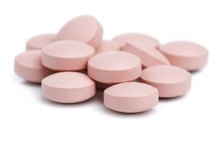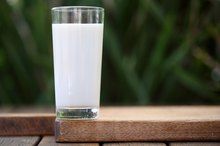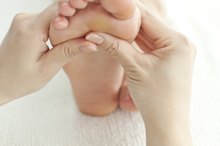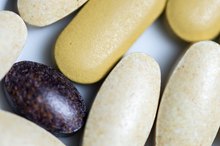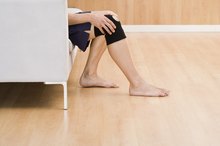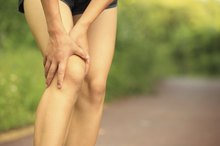Joint Pain and a Vitamin Deficiency
Joint pain can be a symptom of a vitamin deficiency either because the deficiency is actually damaging your joints or because it is damaging your nerves. Vitamins such as A, C and D help support numerous aspects of joint health, and a deficiency in these vitamins might cause or contribute to bone pain.
Vitamin D
According to the Linus Pauling Institute, vitamin D works closely with calcium to maintain a proper balance of the mineral within your body. Insufficient vitamin D impairs the absorption of calcium from your diet, leading your body to take calcium from your bones, weakening your bones and joints. A vitamin D deficiency can also weaken your muscles, which, when combined with weakened bones, can cause joint pain. You should try to get 15 micrograms of vitamin D daily by spending a short time in the sun or through a multivitamin. Consuming fortified cereals and dairy products also boosts your intake.
- According to the Linus Pauling Institute, vitamin D works closely with calcium to maintain a proper balance of the mineral within your body.
- Insufficient vitamin D impairs the absorption of calcium from your diet, leading your body to take calcium from your bones, weakening your bones and joints.
Vitamin C
Which Vitamins Are Good for Muscle Pains?
Learn More
Vitamin C, also called ascorbic acid, is a vitamin that is important in the production of collagen, a key component in tendons, ligaments and bones -- which all have an impact on your joints. A deficiency in vitamin C can cause weakening in the connective tissues that form your joints, leading to joint pain and swelling. For healthy joints, an average adult male needs an intake of 90 milligrams of vitamin C daily, while a female needs 75 milligrams. Load up of veggies and fruits, especially strawberries and red peppers, to fight vitamin C deficiency.
- Vitamin C, also called ascorbic acid, is a vitamin that is important in the production of collagen, a key component in tendons, ligaments and bones -- which all have an impact on your joints.
Vitamin A
Your body needs vitamin A for several processes, including bone growth and cell differentiation -- a process by which a cell becomes part of specialized tissue, like the connective tissue in your joints. An average male needs 3,000 international units a day, while a woman needs 2,333 daily. Sweet potatoes, carrots, spinachm pumpkin and kale all provide ample amounts of vitamin A. A deficiency in vitamin A may damage your bones and connective tissues, leading to joint pain. However, according to the National Institutes of Health's Office of Dietary Supplements, too much vitamin A can also cause joint pain, so you should limit your intake to a maximum of 10,000 IU daily.
- Your body needs vitamin A for several processes, including bone growth and cell differentiation -- a process by which a cell becomes part of specialized tissue, like the connective tissue in your joints.
- However, according to the National Institutes of Health's Office of Dietary Supplements, too much vitamin A can also cause joint pain, so you should limit your intake to a maximum of 10,000 IU daily.
Other Vitamins
Are There Vitamins That Aid Muscle Flexibility?
Learn More
Other vitamin deficiencies can cause damage to nerves, which can also cause joint pain. This is particularly prevalent in people with poor diets and nutrition. Vitamins E, B-1 or thiamin, B-6, B-12, and niacin are necessary for your nerves to grow and develop in a healthy way. Correcting a vitamin deficiency may help your joint pain; however, joint pain can also arise from serious health problems, so if your pain persists, see a doctor.
- Other vitamin deficiencies can cause damage to nerves, which can also cause joint pain.
- Correcting a vitamin deficiency may help your joint pain; however, joint pain can also arise from serious health problems, so if your pain persists, see a doctor.
Related Articles
References
- Linus Pauling Institute: Vitamin D
- American Academy of Orthopaedic Surgeons: Vitamin D for Good Bone Health
- Linus Pauling Institute: Vitamin C
- Office of Dietary Supplements: Dietary Supplement Fact Sheet: Vitamin A and Carotenoids
- U.S. National Library of Medicine. MedlinePlus. Vitamins. Reviewed February 2, 2019.
- U.S. National Library of Medicine. MedlinePlus. Vitamin D Deficiency.
- U.S. National Library of Medicine. MedlinePlus. Vitamin B12 deficiency anemia. Reviewed January 19, 2018.
- U.S. National Library of Medicine. MedlinePlus. Pellagra. Reviewed October 12, 2018.
- National Institute of Neurological Disorders and Stroke. Restless Legs Syndrome Fact Sheet.
- Vici G, Belli L, Biondi M, Polzonetti V. Gluten free diet and nutrient deficiencies: A review. Clin Nutr. 2016;35(6):1236-1241. doi:10.1016/j.clnu.2016.05.002
- Wacker M, Holick MF. Sunlight and Vitamin D: A global perspective for health. Dermatoendocrinol. 2013;5(1):51-108. doi:10.4161/derm.24494
- Crohn’s & Colitis Foundation. Vitamin and Mineral Supplementation.
- Foundation for Peripheral Neuropathy. Vitamin B12 Deficiency Neuropathy.
- U.S. National Library of Medicine. MedlinePlus. Vitamin B Test. Updated May 28, 2019.
- International Foundation for Gastrointestinal Disorder. Malabsorption.
- Diab L, Krebs NF.Vitamin Excess and Deficiency.Pediatr Rev. 2018 Apr;39(4):161-179. doi: 10.1542/pir.2016-0068.
- Thomas-Valdés S, Tostes MDGV, Anunciação PC, da Silva BP, Sant'Ana HMP.Association between vitamin deficiency and metabolic disorders related to obesity.Crit Rev Food Sci Nutr. 2017 Oct 13;57(15):3332-3343. doi: 10.1080/10408398.2015.1117413.
Writer Bio
Joseph McAllister has worked as a writer since 2003. He has more than seven years of experience in training and coaching martial arts. McAllister writes for various websites on a variety of topics including martial arts, competition and fitness. He graduated from Liberty University on a full ride National Merit Scholarship with a Bachelor of Science in print journalism.
